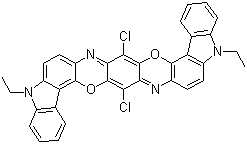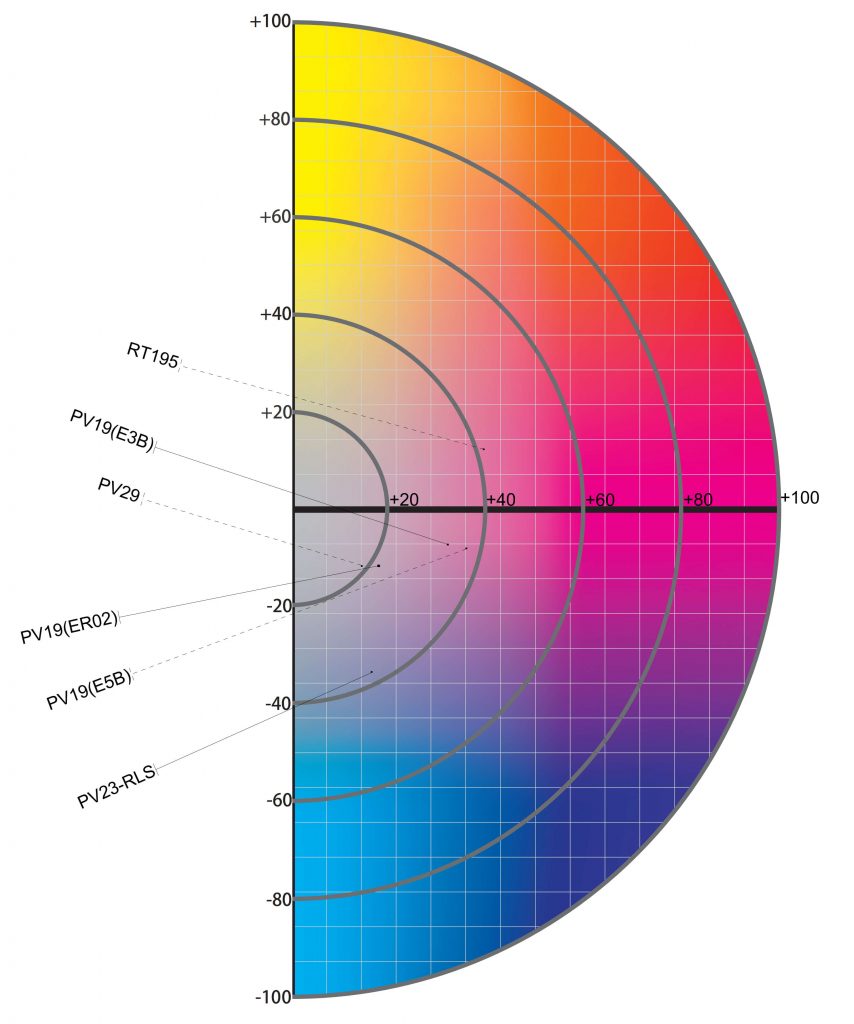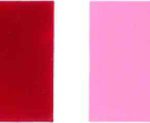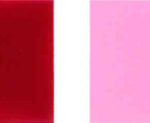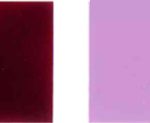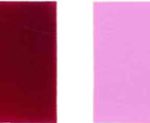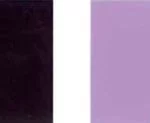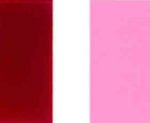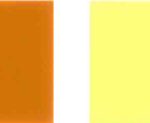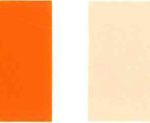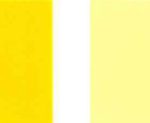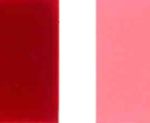Violeta pigmento 23-Corimax Violet RLS
Pigment violet 23 is an organic compound that is a commercial pigment. It is member of the dioxazine family of heterocyclic compounds, but derived from carbazoles. It is prepared by condensation of chloranil and 3-amino-N-ethylcarbazole. It has a centrosymmetric angular structure. For many years, the structure was assigned, incorrectly, as having a "linear structure" (EC no. 228-767-9, CAS RN 6358-30-1) which differ in terms of the carbazole ring fusion.
Pigment violet 23 is prepared by condensation of an aniline with chloranil.[From Wiki]
Parâmetros técnicos do pigmento violeta 23
| Nº de índice de cores | Violeta 23 |
| Nome do Produto | Corimax Violet RLS |
| Categoria de Produto | Pigmento Orgânico |
| Rapidez à luz (revestimento) | 7 |
| Resistência ao calor (revestimento) | 200 |
| Solidez à luz (plástico) | 7 |
| Resistência ao calor (plástico) | 250 |
Cor | 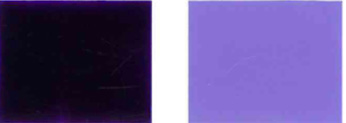 |
| Distribuição de matiz |
Zeyachem is a global supplier of Dioxazine Violet pigments that provide a bluish violet shade, a color not obtainable by other pigments.
The extremely high color strength of Pigment violet 23 makes it a suitable pigment as a shading component. PV23 also exhibits excellent heat fastness and light fastness properties, making it suitable for inks and many paints and coatings applications.
Corimax Violet RLS is a reddish blue shade Dioxazine Violet (PV23) pigment with very high color strength and excellent overall fastness properties, suitable for inks, paints and coatings, including industrial coatings, powder coatings and automotive coatings.
Recursos:
low viscosity, high gloss, high color strength. Pigment Violet 23 is a transparent purple violet pigment with high saturation and tinting strength.
C.I.Pigment Violet 23 show good tinting strength in flexible PVC while poor resistance to immigration.
P.V.23 heat resistance above 230℃ in polyolefins, when used in transparent PS, temperature shall below 220℃, above this PV 23 shall decompose. When worked in polyester, it is 280℃ stable in 5 hours, while concentration shall above 0.05%.
The pigment is easy to use and requires no rinsing. To ensure maximum color intensity and proper adhesion to the pulp, a retention agent must be added to the pulp before the pigment is applied. Our pigments are supplied by volume sizes. The actual weight varies, depending upon the density of the pigment.
Aplicação:
Recomendado para tintas automotivas, revestimentos arquitetônicos, revestimentos de bobina, tintas industriais, revestimentos em pó, pastas para impressão, PVC, borracha, PS, PP, PE, PU, tintas offset, tintas à base de água, tintas à base de água, tintas à base de solvente, tintas UV.
Pigment Violet 23 (PV 23) has now been around for more than 55 years. Its beginnings go back to 1928, when a patent was filed for the pigment after researchers at the Hoechst company in Germany first undertook the multistage synthesis based on carbazole, an ingredient of coaltar, and chloranile. Until the end of World War II the pigment was only used to process diamine light blue, a direct dyestuff for cotton.
With the invention of reactive dyes, which considerably simplified the dyeing and printing process for cellulose fibers, this application lost its importance. A new and promising use for PV 23 was quickly found due to the pigment’s ability to produce unique colors.
PV 23 has been used as a pigment since 1953. PV 23 belongs to the group of high-performance polycyclic pigments (HPP’s) that are used whenever the requirements for a colorant are particularly high. These include high light fastness and weather fastness, fastness to solvents, and heat stability. In addition, PV 23 stands out by its high coloring power. Under the electron microscope, the crude violet shows a highly granular crystalline form, whereas the pigment particles are miniscule.
—————————————————————————————————————— ———————————————
Informação relacionada
Propriedades físicas e químicas:
Matiz ou luz: roxo azul
Densidade relativa: 1.40-1.60
Densidade a granel / (lb / gal): 11,7-13,3
Ponto de fusão / ℃: 430-455
Tamanho médio de partícula / μm: 0,04-0,07
Forma de partícula: cúbico / haste
Superfície específica / (m2 / g): 45-102
Valor do pH / (chorume a 10%): 6,2
Uso do produto:O pigmento violeta 23 é usado principalmente para a coloração de revestimentos, tintas, borrachas e plásticos, e também para a coloração de fibras sintéticas
Existem 124 tipos de marcas de formulação comercial do pigmento. A carbazoazina é um tipo de variedade violeta azul com aplicação forte e incomum, e a área de superfície específica da violeta monolita RN é de 74m2 / g. É amplamente utilizado em vários campos, como revestimento, impressão a tinta, impressão de plásticos e tecidos e tingimento. Possui boa solidez ao verniz ao colorir. Ele pode ser usado para tinta de secagem ao ar, OEM para pintura automotiva e tinta para assar, especialmente para tinta látex com toner CuPc e tom claro forte. Pode ser usado para colorir plástico, com resistência ao calor de 280 ℃ em poliolefina e alta retenção de cores (apenas 0,07% da concentração de pigmento é necessária para o HDPE com 1 / 3SD); também pode ser usado para colorir poliéster e PE.
Princípio da síntese: O carbazol é usado como matéria-prima e a N-etilação é realizada sob pressão normal na presença de um catalisador de inversão de fase, e uma reação de nitração e uma reação de redução são realizadas para sintetizar 2-amino-N-etilcarbazol; A 3,5,6-tetracloroparaquinona (cloranil) é submetida a reações de condensação e fechamento do anel, filtrada, lavada com água e seca para obter uma violeta de carbazol em bruto; finalmente, tratamento geral da pigmentação, amassando ou amassando para obter o pigmento violeta CI 23.
apelido:Pigment Violet RL; 51319; C.I. Pigment Violet 23; 8,18-Dichloro-5,15-diethyl-5,15-dihydrodiindolo(3,2-b:3',2'-m)tri- phenodioxazine; CI 51319; Diindolo(3,2-b:3',2'-m-)triphenodioxazine, 8,18-dichloro-5,15-diethyl-5,15-dihydro-; Carbazole Dioxazine Violet; Carbazole Violet; Chromofine Violet RE; Cyanadur Violet; Dioxazine Violet; Dioxazine purple; EB Violet 4B7906; EMC Violet RL 10; Fastogen Super Violet RN; Fastogen Super Violet RN-S; Fastogen Super Violet RTS; Fastogen Super Violet RVS; Helio Fast Violet BN; Heliofast Red Violet EE; Heliogen Violet; Heliogen Violet R Toner; Hostaperm Violet RL; Hostaperm Violet RL Special; Hostaperm Violet RL Special 14-4007; Lake Fast Violet RL; Lake Fast Violet RLB; Lionogen Violet R 6100; Lionogen Violet RL; Lionol Violet HR; Monolite Fast Violet R; PV Fast Violet BL; PV Fast Violet RL-SPE; Paliogen Violet 5890; Paliogen Violet L 5890; Permanent Violet; Permanent Violet R; Sandorin Violet BL; Sanyo Permanent Violet BL-D 422; Sumikacoat Fast Violet RSB; Sumitone Fast Violet RL; Sumitone Fast Violet RL 4R; Sumitone Fast Violet RLS; Symuler Fast Violet BBL; Symuler Fast Violet BBLN; Unisperse Violet B-E; Vynamon Violet 2B; 8,18-Dichloro-5,15-diethyl-5,15-dihydrodiindolo(3,2-b:3',2'-m)triphenodioxazine; Diindolo(3,2-b:3',2'-m)triphenodioxazine, 8,18-dichloro-5,15-diethyl-5,15-dihydro-; 8,18-dichloro-5,15-diethyl-5,15-dihydrocarbazolo[3',2':5,6][1,4]oxazino[2,3-b]indolo[2,3-i] phenoxazine
Estrutura molecular: